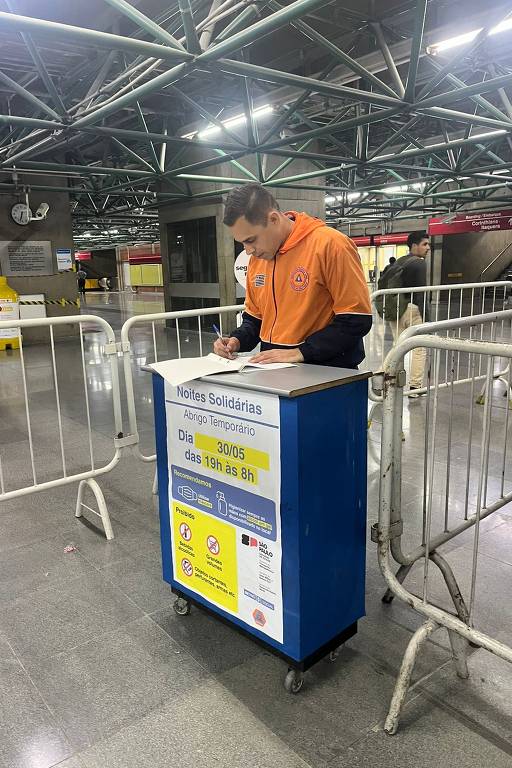With just one blanket, couple waits more than two hours for a place in a hostel in SP

Lícia, 27, and her partner, who asked not to be identified, remained hugging in temperatures below 15°C, in Praça da República, in downtown São Paulo , around 1 am this Wednesday (25).
They shared the only blanket they had while they waited since 10:30 pm for a place in a hostel that accepted couples.
The city recorded the coldest morning of the year this Wednesday, with 6.6ºC at around 4 am. The temperature was recorded by thermometers at the automatic station of Inmet (National Institute of Meteorology) in Mirante de Santana, in the north zone.

She says that the two have been on the streets for a month and a half, after she was dismissed from the POT (Work Operation Program). "I couldn't enroll in a course because my documents were stolen," she says. The couple was trying to resolve the problem on Paulista Avenue and, because of that, she says they arrived late at Praça da República.
When they arrived, the service had already ended. They were unable to get another blanket, soup or other hot drink, or water. When they arrived, there were only professionals responsible for directing them to shelters at the location. With the promise of a place, they waited to be called to get on the van. Later, they received the news that they had found places for them.
Officials reported that they had already managed to take more than 20 people from Praça da República alone to municipal shelters. Four units were receiving homeless people who were in the square.
At around 2:30 a.m., with temperatures slightly lower, Nayara Santos was still waiting for a van to take her from Pateo do Collegio to some shelter. She called the city hall's 156 number for the second time to get help.
With her mouth swollen and other signs of aggression, Nayara wanted to go to the shelter not only to ensure a night's sleep without the cold of the streets. "I intend to report my ex-husband for assault," she says. She says she ran away from home, in the interior of São Paulo, after being assaulted by her then partner.
With nowhere to go, he went to the Marco Zero shelter in the capital of São Paulo in the hope of getting help. "If I check into the shelter, I know that the social worker can send me there the next morning to file a police report and undergo a forensic examination," he says.
She hoped not to have to stay on the street and chose to wait at a spot where the metropolitan civil guards were present, which gave her some sense of security. "The street is more dangerous for women than for men," she says.
With bonfires in the streets, many homeless people preferred to face the cold without going to shelters. At least two of them, one in the central region and another in the Mooca sub-prefecture region, said they could not be sheltered because they were restricted to the units in the region. The restriction is a punishment for acts of indiscipline.
In Mooca, in the east zone, one of them said that his cart had been seized the previous week, which was making it difficult for him to survive. He said that he had bought it for R$1,000 and had not even finished paying off the installments.
On General Olímpio da Silveira Street, below the Minhocão, in downtown São Paulo, homeless people said that their lives became more difficult after the spread of Cracolândia (which attracted drug users to the surrounding area) and the installation of a Military Police base in Marechal Deodoro Square.
According to them, there was a considerable reduction in donations after these two changes.
The lack of space to shelter pets, pest outbreaks and fights are the main reasons given by homeless people for refusing to go to shelters. The rigid schedules are also a hindrance, especially for people who are picked up in the middle of the night and would therefore have few hours of sleep.
On the streets, many complain about the lack of support outside the shelter system. Blankets that are collected by the inspectors, for example.
In a statement, the city government stated that the city has "the largest social assistance network in Latin America, with more than 26 thousand vacancies in 380 services" and that "the average occupancy rate in these services in the month of June is 82%".
He added that guides from the Specialized Social Approach Service (SEAS) work in the tents and intensify the work of approaching people on the streets, offering support.
"If accepted, people are taken to one of the facilities in the social assistance network, always respecting the type of people being welcomed (single people, people with disabilities, families, elderly people and the LGBTQIAPN+ population). In the services, those served have spaces for overnight stays and bathing, as well as meals such as dinner and breakfast."
uol




